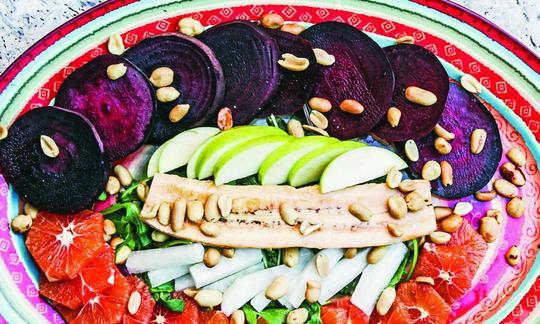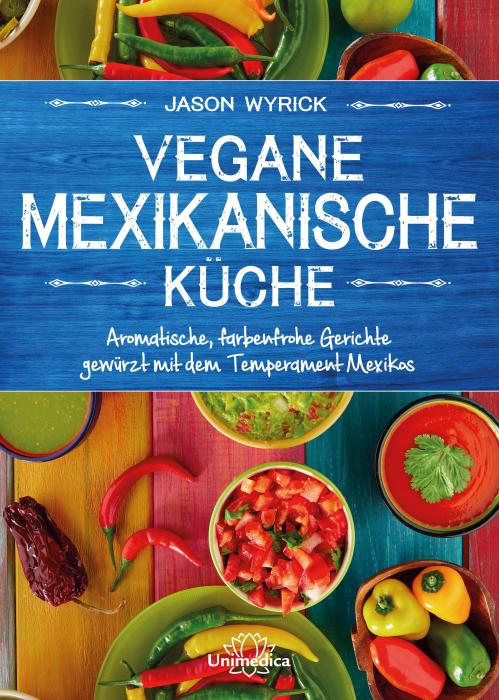Christmas Eve Salad with Red Beets, Arugula, and Jicama
vegan
Ingredients (for servings, )
| For the Christmas Eve Salad | |
|---|---|
| 1 small | Beetroot, raw (organic?) (3.5 oz) |
| 1 | Oranges, raw (organic?) (4.6 oz) |
| 1 | Yam bean (tuber bean, jícama, benkuang), raw, organic? (23 oz) |
| 1 | Granny Smith apple, raw (organic?) (5.9 oz) |
| 1 | Plantain (cooking banana, flour plantain), raw, organic? (6.3 oz) |
| 1 ⅜ oz | Peanuts (raw?, organic?) |
| 3 ½ oz | Rocket, raw (organic?) |
| For the dressing | |
| 1 | Oranges, raw (organic?) (4.6 oz) |
| 1 | Limes, raw (organic?) (2.4 oz) |
Equipment
- vegetable peeler
- skillet (frying pan)
- stove
- citrus juicer (lemon squeezer)
- saucepan
Type of preparation
- cook
- squeeze
- dry roast
- peel
Preparation
For the Christmas Eve Salad
Peel the red beet and orange, and cut both into 1/4-inch (0.6 cm) thick discs. Peel the jicama and cut into 1/2-inch (1.2 cm) pieces together with the apple. Peel the plantain and cut into 3/4-inch (2 cm) pieces.The original recipe for 5–6 servings calls for a medium-size green apple and a very small jicama.
When peeling the red beet, you may want to wear gloves in order to prevent your hands from being stained a reddish, violet color.
Simmer the beet slices in a small saucepan with enough water to cover over medium heat until just soft, about 4 minutes, then remove from the heat. Remove the beets, set aside, and reserve the simmering liquid for use in the dressing.
Briefly toast the peanuts in a skillet. If you prefer, you can use pepitas instead. Combine the red beet, arugula, orange, apple, jicama, plantain, and peanuts or pepitas in a salad bowl or arrange them on a platter.
If you want to prepare this salad in advance, add the arugula just before serving and combine.
Pepitas (in Spanish “small pumpkin seeds”) are hulled, green pumpkin seeds.
Ratio of fatty acids: For a better ratio of the two essential fatty acids, you can use walnuts instead of the peanuts. Use without toasting. This substitution will bring the ratio of omega-6 to omega-3 fatty acids down to 4:1.
For the dressing
Juice the orange and the lime. In a small bowl, combine the orange juice, lime juice, and 3–4 tablespoons beet water.Optional: For a recipe that makes 5–6 servings, the author Jason Wyrick includes the following optional ingredients for the dressing: 1 (2-inch) piece piloncillo or 2 tablespoons brown sugar melted into simmering liquid, as well as crushed chiles de árbol to taste.
Serving
Let the dressing come to room temperature and pour it over the salad.
|
Nutritional Information per person
Convert per 100g
|
2000 kcal | |
|---|---|---|
| Energy | 201 kcal | 10.0% |
| Fat/Lipids | 4.5 g | 6.4% |
| Saturated Fats | 0.62 g | 3.1% |
| Carbohydrates (inc.dietary fiber) | 39 g | 14.5% |
| Sugars | 18 g | 20.2% |
| Fiber | 11 g | 45.6% |
| Protein/Albumin | 5.0 g | 10.1% |
| Cooking Salt (Na:29.6 mg) | 75 mg | 3.1% |
| Essential micronutrients with the highest proportions | per person | 2000 kcal | |
|---|---|---|---|
| Vit | Vitamin C (ascorbic acid) | 72 mg | 90.0% |
| Vit | Vitamin B9, B11 (Folate, as the active form of folic acid) | 102 µg | 51.0% |
| Elem | Potassium, K | 719 mg | 36.0% |
| Vit | Vitamin K | 24 µg | 31.0% |
| Min | Copper, Cu | 0.26 mg | 26.0% |
| Min | Manganese, Mn | 0.39 mg | 20.0% |
| Vit | Vitamin B6 (pyridoxine) | 0.27 mg | 19.0% |
| Elem | Magnesium, Mg | 64 mg | 17.0% |
| Vit | Vitamin B1 (Thiamine) | 0.17 mg | 15.0% |
| Min | Iron, Fe | 2.0 mg | 14.0% |
Detailed Nutritional Information per Person for this Recipe
The majority of the nutritional information comes from the USDA (US Department of Agriculture). This means that the information for natural products is often incomplete or only given within broader categories, whereas in most cases products made from these have more complete information displayed.
If we take flaxseed, for example, the important essential amino acid ALA (omega-3) is only included in an overarching category whereas for flaxseed oil ALA is listed specifically. In time, we will be able to change this, but it will require a lot of work. An “i” appears behind ingredients that have been adjusted and an explanation appears when you hover over this symbol.
For Erb Muesli, the original calculations resulted in 48 % of the daily requirement of ALA — but with the correction, we see that the muesli actually covers >100 % of the necessary recommendation for the omega-3 fatty acid ALA. Our goal is to eventually be able to compare the nutritional value of our recipes with those that are used in conventional western lifestyles.
| Essential fatty acids | per person | 2000 kcal |
|---|---|---|
| Linoleic acid; LA; 18:2 omega-6 | 1.3 g | 13.0% |
| Alpha-Linolenic acid; ALA; 18:3 omega-3 | 0.07 g | 3.0% |
| Essential amino acids | per person | 2000 kcal |
|---|---|---|
| Tryptophan (Trp, W) | 0.03 g | 14.0% |
| Threonine (Thr, T, irreversibly transaminated) | 0.12 g | 13.0% |
| Phenylalanine (Phe, F) | 0.17 g | 11.0% |
| Isoleucine (Ile, I) | 0.13 g | 10.0% |
| Valin (Val, V) | 0.16 g | 10.0% |
| Leucine (Leu, L) | 0.21 g | 9.0% |
| Lysine (Lys, K, irreversibly transaminated) | 0.17 g | 9.0% |
| Methionine (Met, M) | 0.06 g | 6.0% |
| Vitamins | per person | 2000 kcal |
|---|---|---|
| Vitamin C (ascorbic acid) | 72 mg | 90.0% |
| Vitamin B9, B11 (Folate, as the active form of folic acid) | 102 µg | 51.0% |
| Vitamin K | 24 µg | 31.0% |
| Vitamin B6 (pyridoxine) | 0.27 mg | 19.0% |
| Vitamin B1 (Thiamine) | 0.17 mg | 15.0% |
| Vitamin E, as a-TEs | 1.6 mg | 13.0% |
| Vitamin B5 (Pantothenic acid) | 0.71 mg | 12.0% |
| Vitamin B3 (Niacin) | 1.8 mg | 11.0% |
| Vitamin B7 (Biotin, ex vitamin H) | 5.6 µg | 11.0% |
| Vitamin B2 (Riboflavin) | 0.12 mg | 9.0% |
| Vitamin A, as RAE | 53 µg | 7.0% |
| Essential macroelements (macronutrients) | per person | 2000 kcal |
|---|---|---|
| Potassium, K | 719 mg | 36.0% |
| Magnesium, Mg | 64 mg | 17.0% |
| Phosphorus, P | 98 mg | 14.0% |
| Calcium, Ca | 86 mg | 11.0% |
| Sodium, Na | 30 mg | 4.0% |
| Essential trace elements (micronutrients) | per person | 2000 kcal |
|---|---|---|
| Copper, Cu | 0.26 mg | 26.0% |
| Manganese, Mn | 0.39 mg | 20.0% |
| Iron, Fe | 2.0 mg | 14.0% |
| Zinc, Zn | 0.75 mg | 8.0% |
| Selenium, Se | 2.6 µg | 5.0% |
| Iod, I (Jod, J) | 2.4 µg | 2.0% |
Narayana Verlag GmbH /Unimedica Verlag , Jason Wyrick
Raw recipes 21 (1), Cooked recipes 117 (3)
Additional photos (4)
"Vegan Mexican Cuisine – Aromatic, colorful dishes seasoned with the temperament of Mexico" provides a comprehensive insight into Mexican cuisine.
Since this book is written in German, a description is omitted here. If you are interested, please switch to German in the menu.
This eye-catching salad contains red beets, arugula, oranges, jicama, and plaintains. In Mexico, it is traditionally served on Christmas Eve.
Nutritional profile: According to GDA guidelines, one serving of this recipe covers more than 50% of the recommended daily requirement for vitamin C and folic acid.
Christmas Eve Salad: According to the author, this recipe is a traditional Mexican Christmas Eve salad. He writes, There are so many variations on it that I could recite a hundred different versions, but at its heart, it’s a colorful fruit salad using in-season ingredients and almost always features citrus.
Plantains: Plantains (Musa paradisiaca), which are found in some countries in the Americas, Africa, and Asia, are a staple food, much in the same way potatoes are in Europe. Plantains can only be eaten raw when they are fully ripe, and when they are immature they are first boiled, grilled, or baked. In comparison to dessert bananas, plantains contain significantly more starch and less sugar. Plantain flour is a good substitute for conventional wheat flour for people on a gluten-free diet, especially for those who suffer from celiac disease.
Red beets: Red beets, also known as beetroot, are particularly well known for their deep red color that comes from the high concentration of the glycoside betanin, a compound in the betalain class of pigments. They can be used raw, cooked, or roasted. Red beets contain high levels of vitamin B, potassium, iron, and folic acid, and thanks to the nitrates they contain, they can help to reduce blood pressure. If larger quantities are consumed, it can cause urine and bowel movements to have a red color, but this is harmless and will pass. Red beets contain high levels of oxalic acid, which is why individuals who are at risk for developing kidney stones, such as Crohn’s disease patients, should avoid eating large amounts this vegetable.
Arugula: Arugula is a popular variety of greens that encompasses a number of plant species. The plants all contain mustard oil glycosides that give them a spicy, bitter flavor. It is best to use young arugula for salad as older, more mature leaves can have a very strong, almost spicy flavor. These are therefore best used as herbs for seasoning. The leaves will generally taste bitter if they are harvested after the plant blooms.
Ripe plantains: Raw plantains are used in this recipe. Unlike dessert bananas (common bananas), they can only be eaten raw when fully ripe. The peel of plantains that are fully ripe will be almost completely black.
Preventing stains: When peeling the beets, you may want to wear rubber gloves in order to prevent your hands from being stained a reddish, violet color.
Dressing ingredients: For a recipe that makes 5–6 servings, the author Jason Wyrick includes the following optional ingredients for the dressing: 1 (2-inch) piece piloncillo or 2 tablespoons brown sugar melted into simmering liquid, as well as crushed chiles de árbol to taste. Piloncillo, also known as panela, is a dark brown, unrefined sugar that is used in Latin America.
Peanuts or pepitas: You can use either toasted peanuts or pepitas for the salad. Pepitas are hulled, green pumpkin seeds that are particularly popular in South and Central American cuisine. Pepitas have a deep, nutty taste and will give the recipe a different flavor.
Walnuts: For a better ratio of the two essential fatty acids, you can use walnuts instead of the peanuts. Use without toasting. Although the two ingredients taste quite a bit different, using walnuts will optimize the ratio of omega-6 to omega-3 fatty acids.




